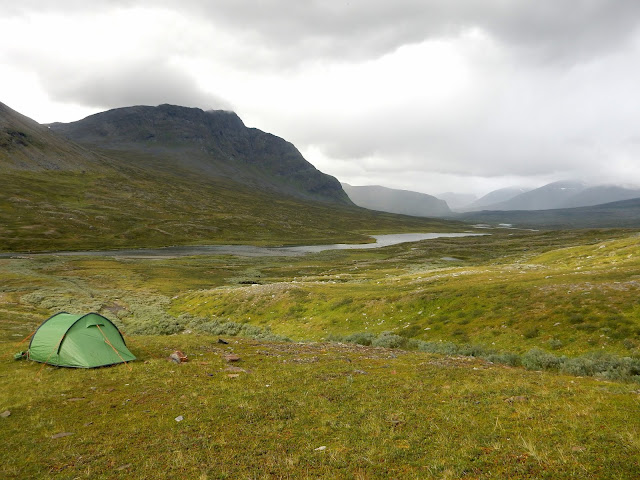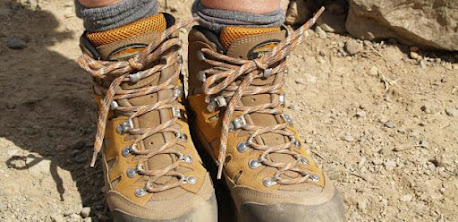Trekking and wild camping in the rain: my method how to stay comfortable
My father hates rain. He once wondered about how I was managing to hike and wild camp during days of rain without growing to hate the whole experience. It got me thinking - my answer is quite simple, honestly. You just need a system that works well for you, allowing you to sleep dry and warm at night. This is my method in 5 steps. If you're still figuring out yours, maybe this will help.
1 - I invested a long time ago in good quality rainjacket and rainpants, DWR-proofed, breathable and with a membrane. 3-layer ones are expensive, but they are lightweight and the most durable. You don't need Gore-tex, though - other kind of membranes work just as well, so you can save some money there. I wear them over a base layer and maybe another, insulating layer if it's close to freezing. It does get a little clammy even inside breathable waterproofs, but they keep me warm and comfy while hiking, even if I walk in the rain and wind all day long. When taking a long break, I put on an additional layer underneath my waterproof jacket to stay warm. But most of the time I don't take long breaks when it rains, instead just snacking and drinking on the go. A thin hat and gloves also really help to keep you happy. And they don't need to be waterproof to still keep your head and fingers warm.
2 - I always make sure everything that shouldn't get wet is packed 100% waterproof in nylon drybags. To keep the majority of rain out of my backpack, I then throw on a raincover. I've got a seperate raincover for my camerabag.
3 - On to the camping. I have a pitch-all-in-one tent. In those models, the inner tent is already attached with hooks to the rainfly, so you can just slip the tent poles through the rainfly and put the whole tent up in one go. The great upside of tent models like these is that the rainfly protects the inner from getting soaked while you set it up in pouring rain. It also allows you to detach a part of the inner tent to create room for wet gear and for cooking inside. Before pitching, make sure your campsite won't flood during the night - don't pitch it too near a stream or river, or on the lowest place. A higher platform or on a slight slope is best.
4 - Once my tent is up, I crawl inside and wrestle out of my shoes and waterproofs. I leave them in the porch. That done, I inflate my sleeping pad. Now I have a dry place to get out of my day clothes, which will probably a bit damp and sweaty, and into thermoclothing and a down jacket for the evening. Then I'll make myself a hot drink and a hot meal. By this time, the inner tent will be completely dry again from last night's condensation (it's amazing how fast thin synthetiscs dry), and I'm perfectly warm and dry and happy inside. It's feels so cozy to be comfortable inside a tent when the rain ticks on the tent fabric.
5 - The next morning, I pack up my things while still inside the tent, leaving only the sleeping pad. The next step is to get out of your night clothes and into your clammy, cold day clothes and waterproofs. An uncomfy moment for sure. I then pack my night clothes and sleeping pad and throw my backpack with the raincover on outside. All I have to do then is quickly take down the tent, throw it on top in my backpack and I'm on my way again, the moving quickly getting me warm and comfortable again.
 |
| Approaching rain in the majestic Tjäktja valley, Sápmi/ north Sweden. |
1 - I invested a long time ago in good quality rainjacket and rainpants, DWR-proofed, breathable and with a membrane. 3-layer ones are expensive, but they are lightweight and the most durable. You don't need Gore-tex, though - other kind of membranes work just as well, so you can save some money there. I wear them over a base layer and maybe another, insulating layer if it's close to freezing. It does get a little clammy even inside breathable waterproofs, but they keep me warm and comfy while hiking, even if I walk in the rain and wind all day long. When taking a long break, I put on an additional layer underneath my waterproof jacket to stay warm. But most of the time I don't take long breaks when it rains, instead just snacking and drinking on the go. A thin hat and gloves also really help to keep you happy. And they don't need to be waterproof to still keep your head and fingers warm.
2 - I always make sure everything that shouldn't get wet is packed 100% waterproof in nylon drybags. To keep the majority of rain out of my backpack, I then throw on a raincover. I've got a seperate raincover for my camerabag.
 |
| Climbing the vulcano Hekla in Iceland. Wet, cold and no view at all - yet we still managed to have a good time. |
3 - On to the camping. I have a pitch-all-in-one tent. In those models, the inner tent is already attached with hooks to the rainfly, so you can just slip the tent poles through the rainfly and put the whole tent up in one go. The great upside of tent models like these is that the rainfly protects the inner from getting soaked while you set it up in pouring rain. It also allows you to detach a part of the inner tent to create room for wet gear and for cooking inside. Before pitching, make sure your campsite won't flood during the night - don't pitch it too near a stream or river, or on the lowest place. A higher platform or on a slight slope is best.
4 - Once my tent is up, I crawl inside and wrestle out of my shoes and waterproofs. I leave them in the porch. That done, I inflate my sleeping pad. Now I have a dry place to get out of my day clothes, which will probably a bit damp and sweaty, and into thermoclothing and a down jacket for the evening. Then I'll make myself a hot drink and a hot meal. By this time, the inner tent will be completely dry again from last night's condensation (it's amazing how fast thin synthetiscs dry), and I'm perfectly warm and dry and happy inside. It's feels so cozy to be comfortable inside a tent when the rain ticks on the tent fabric.
5 - The next morning, I pack up my things while still inside the tent, leaving only the sleeping pad. The next step is to get out of your night clothes and into your clammy, cold day clothes and waterproofs. An uncomfy moment for sure. I then pack my night clothes and sleeping pad and throw my backpack with the raincover on outside. All I have to do then is quickly take down the tent, throw it on top in my backpack and I'm on my way again, the moving quickly getting me warm and comfortable again.
 |
| An especially wet week of walking in the Lake District national park, north England, Februari. |



Comments
Post a Comment